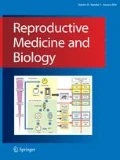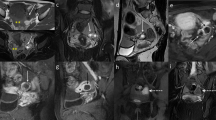Abstract
Purpose
To evaluate preoperative magnetic resonance (MR) imaging features of bleeding and non-bleeding ectopic pregnancy (EP) by comparison with surgical findings.
Methods
Eighteen suspected EP cases underwent preoperative MR imaging. We classified 8 cases as the bleeding group and 7 cases as the non-bleeding group with or without intra-abdominal bleeding and/or hematoma at the site of EP, and compared, retrospectively, gestational sac (GS)-like structure, particularly the peripheral area of the GS via MR analysis. Excluded were 3 cases that were insufficient for assessing extrauterine GS-like structure: ruptured tubal pregnancy and uterine horn pregnancy.
Results
GS-like structures were typically observed as low intensity on T1-weighted image (T1WI) and as high intensity on T2-weighted image (T2WI). In non-bleeding cases, most peripheral areas of the GS were of intermediate intensity on T1WI and high intensity on T2WI. Most bleeding cases were of high intensity on T1WI and low to high intensity on T2WI. Furthermore, the peripheral area of the GS was of higher intensity on T1WI with fat suppression than on T1WI.
Conclusions
It is clear that MR imaging is effective for diagnosis of cases of suspected EP. EP conditions may be predicted by signal intensity of the peripheral area of the GS via MR analysis.




Similar content being viewed by others
References
Abdel LS, Hjalmar AS. Transvaginal sonography in the management of ectopic pregnancy. Acta Obstet Gynecol Scand. 1995;74:293–6.
Shalev E, Yarom I, Bustan M, Bustan M, Weiner E, Ben-Shlomo I. Transvaginal sonography as the ultimate diagnostic tool for the management of ectopic pregnancy: experience with 840 cases. Fertil Steril. 1998;69:62–5.
Condous G, Okaro E, Khalid A, Lu C, Van Huffel S, Timmerman D, et al. The accuracy of transvaginal ultrasonography for the diagnosis of ectopic pregnancy prior to surgery. Hum Reprod. 2005;20:1404–9.
Atri M, Leduc C, Gillett P, Bret PM, Reinhold C, Kintzen G, et al. Role of endovaginal sonography in the diagnosis and management of ectopic pregnancy. Radiographics. 1996;16:755–74.
Kataoka ML, Togashi K, Kobayashi H, Inoue T, Fujii S, Konishi J. Evaluation of ectopic pregnancy by magnetic resonance imaging. Hum Reprod. 1999;14:2644–50.
Nagayama M, Watanabe Y, Okumura A, Amoh Y, Nakashita S, Dodo Y. Fast MR imaging in obstetrics. Radiographics. 2002;22:563–80.
Kinoshita T, Ishii K, Higashiiwai H. MR appearance of ruptured tubal ectopic pregnancy. Eur J Radiol. 1999;32:144–7.
Takeuchi K, Yamada T, Oomori S, Ideta K, Moriyama T, Maruo T. Comparison of magnetic resonance imaging and ultrasonography in the early diagnosis of interstitial pregnancy. J Reprod Med. 1999;44:265–8.
Hricak H, Lacey C, Schriock E, Fisher MR, Amparo E, Dooms G, et al. Gynecologic masses: value of magnetic resonance imaging. Am J Obstet Gynecol. 1985;153:31–7.
Hamada S, Naka O, Moride N, Higuchi K, Takahashi H. Ultrasonography and magnetic resonance imaging findings in a patient with an unruptured interstitial pregnancy. Eur J Obstet Gynecol Reprod Biol. 1997;73:197–201.
Nishino M, Hayakawa K, Kawamata K, Iwasaku K, Takasu K. MRI of early unruptured ectopic pregnancy: detection of gestational sac. J Comput Assist Tomogr. 2002;26:134–7.
Yoshigi J, Yashiro N, Kinoshita T, Ouchi T, Kitagaki H. Diagnosis of ectopic pregnancy with MRI: efficacy of T2*-weighted imaging. Magn Reson Med Sci. 2006;5:25–32.
Tamai K, Koyama T, Togashi K. MR features of ectopic pregnancy. Eur Radiol. 2007;17:3236–46.
Takeuchi H, Kuwatsuru R. The indications, surgical techniques, and limitations of laparoscopic myomectomy. JSLS. 2003;7:89–95.
Kuroda K, Takeuchi H, Kitade M, Kikuchi I, Shimanuki H, Kumakiri J, et al. Assessment of tubal disorder as a risk factor for repeat ectopic pregnancy after laparoscopic surgery for tubal pregnancy. J Obstet Gynecol Res. 2009;35:520–4.
Kumakiri J, Takeuchi H, Kitade M, Kikuchi I, Shimanuki H, Kubo M, et al. Interstitial pregnancy with huge adenomyosis uteri managed laparoscopically by using pre-operative and intra-operative imaging: case report. BJOG. 2005;112:1578–80.
Bradley WG Jr. MR appearance of hemorrhage in the brain. Radiology. 1993;189:15–26.
Lozeau AM, Potter B. Diagnosis and management of ectopic pregnancy. Am Fam Physician. 2005;72:1707–14.
Hajenius PJ, Mol F, Mol BW, Bossuyt PM, Ankum WM, van der Veen F. Interventions for tubal ectopic pregnancy. Cochrane Database Syst Rev. 2007;1:CD000324.
Wong JA, Clark JF. Correlation of symptoms with age and location of gestation in tubal pregnancy. J Natl Med Assoc. 1968;60:221–3.
Della-Giustina D, Denny M. Ectopic pregnancy. Emerg Med Clin N Am. 2003;21:565–84.
Murray H, Baakdah H, Bardell T, Tulandi T. Diagnosis and treatment of ectopic pregnancy. CMAJ. 2005;173:905–12.
Hajenius PJ, Mol BW, Ankum WM, van der Veen F, Bossuyt PM, Lammes FB. Clearance curves of serum human chorionic gonadotrophin for the diagnosis of persistent trophoblast. Hum Reprod. 1995;10:683–7.
Balci O, Ozdemir S, Mahmoud AS, Acar A, Colakoglu MC. The efficacy of multiple-dose methotrexate treatment for unruptured tubal ectopic pregnancy and conversion rate to surgery: a study on 294 cases. Fertil Steril. 2010;93:2415–7.
Kemmann E, Trout S, Garcia A. Can we predict patients at risk for persistent ectopic pregnancy after laparoscopic salpingotomy? J Am Assoc Gynecol Laparosc. 1994;1:122–6.
Author information
Authors and Affiliations
Corresponding author
About this article
Cite this article
Kuroda, M., Kuroda, K., Kuwatsuru, R. et al. Use of magnetic resonance analysis for clinical evaluation of the peripheral area of gestational sac in bleeding and non-bleeding ectopic pregnancy cases. Reprod Med Biol 11, 95–100 (2012). https://doi.org/10.1007/s12522-011-0114-5
Received:
Accepted:
Published:
Issue Date:
DOI: https://doi.org/10.1007/s12522-011-0114-5




